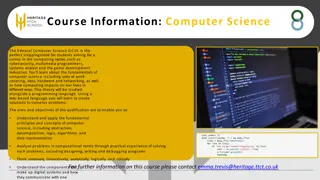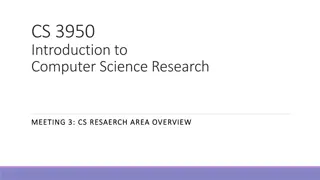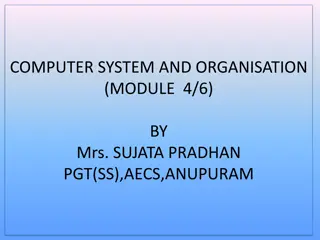Understanding Number Systems in Computer Science
Exploring how modern computer systems represent numeric values using various numbering systems such as binary, decimal, and hexadecimal. Discover the fundamentals of each system, their importance in digital systems, and methods for representing negative integers.
Download Presentation

Please find below an Image/Link to download the presentation.
The content on the website is provided AS IS for your information and personal use only. It may not be sold, licensed, or shared on other websites without obtaining consent from the author. Download presentation by click this link. If you encounter any issues during the download, it is possible that the publisher has removed the file from their server.
E N D
Presentation Transcript
CHAPTER TWO 2. Data Representation 2. Data Representation 1
Numbering Systems Numbering Systems Most modern computer systems do not represent numeric values using the decimal system. Numbering system it uses a specific radix (base). Radices that are power of 2 are widely used in digital systems. These radices include: Binary (base 2), Quaternary (base 4), Octagonal (base 8), Decimal (base 10) and Hexagonal (base 16). The base 2 binary system is dominant in computer systems. 2
The Decimal Number System In everyday life we use a system based on decimal digits (0, 1, 2, 3, 4, 5, 6, 7, 8, 9) to represent numbers and refer to the system as the decimal system. Example: the number 83 means. It means eight tens plus three: 83 = (8 * 10) + 3 The decimal system is said to have a base, or radix, of 10. This means that each digit in the number is multiplied by 10 raised to a power corresponding to that digit s position: The same principle holds for decimal fractions but negative powers of 10 are used. Example: the decimal fraction 0.256 stands for 2 tenths plus 5 hundredths plus 6 thousandths (2*10-1 + 5*10-2 + 6*10-3) In general, for the decimal representation of The value of X is 3
The Binary Number System The Binary Number System In the decimal system, 10 different digits are used to represent numbers with a base of 10. In the binary system, we have only two digits, 1 and 0.Thus, numbers in the binary system are represented to the base 2. In general, for the binary representation of the value of Y is Example: (1001.10001)2 4
Hexadecimal Number System Hexadecimal Number System We use 16 different symbols, The notation is called hexadecimal, and the 16 symbols are the hexadecimal digits. Hexadecimal notation is used for representing of integers, any sequence of binary digits, whether they represent text, numbers, or some other type of data. The reasons for using hexadecimal notation are: I. It is more compact than binary notation. II. In most computers, binary data occupy some multiple of 4 bits, and hence some multiple of a single hexadecimal digit. III. It is extremely easy to convert between binary and hexadecimal. Example: (110111100001)2 equivalent to (DE1)16 5
Negative Integer Representation There exist a number of methods for representation of negative integers. These includes: the sign-magnitude, the radix/base complement, Sign-Magnitude According to this representation, The most significant bit (of the n bits used to represent the number) is used to represent the sign of the number If in the most significant bit position is 1 , it indicates a negative number while a If 0 in the most significant bit position, it indicates a positive number. 6
Cont. The remaining (n-1) bits are used to represent the magnitude of the number. For example: the negative number (-18) is represented using 6 bits, base 2 in the sign- magnitude format, as follows (110010), while a (+18) is represented as (010010). Although the sign-magnitude representation is complicated when performing arithmetic operations. for example, the addition of the two numbers +18 (010010) and -19 (110011) using the sign-magnitude representation. Since the two numbers carry different signs, then the result should carry the sign of the larger number in magnitude, in this case the (-19). The remaining 5-bit numbers are subtracted (10011 - 10010) to produce (00001), that is, (-1). 7
Radix Complement According to this system: The positive number is represented the same way as in the sign-magnitude. But the negative number is represented using the b s complement (b for base numbers). For example, the representation of the number (-19) using 2 s complement. In this case, the number 19 is first represented as (010011). Then each digit is complemented, hence the name radix complement to produce (101100). Finally a 1 is added at the least significant bit position to result in (101101). Example2: consider the 2 s complement representation of the number (+18). Since the number is positive, then it is represented as (010010), the same as in the sign-magnitude case. 8
Twos Complement (2s) Representation To represent a number in 2 s complement, we perform the following two steps. 1. Perform the Boolean complement of each bit (including the sign bit); 2. Add 1 to the least significant bit (i.e. -A= A + 1) Example: Consider the representation of (-22) using 2 s complement. The main advantage of the 2 s complement representation: Solution: 22=00010110 11101001 1 s complement + 1 11101010 (-22) I. is that no special treatment is needed for the sign of the numbers. II. If carry coming out of the most significant bit while performing arithmetic operations is ignored without affecting the correctness of the result (i.e. no effect in result!) 9
Twos Complement Arithmetic operations A. Addition: Addition of two n-bit numbers in 2 s complement can be performed using an n-bit adder. Any carry-out bit can be ignored without affecting the correctness of the results, as long as the results of the addition is in the range -2n-1 to 2n-1 -1 Example: (-7 )+ (+4)= -3 that is, (1001 )+ (0100) = 1101, a (-3) in 2 s complement. (+6)+(+7)=+13, that is, 0111 + (0110) = 1101, a wrong result. This is because the result exceeds the largest value (+7). Example2: (-7)+(-4)=-11 , that is, 1001+ (1100) = 0101, a wrong result. This is because the result is less than the smallest value (-8). Notice that the original numbers are negative while the result is positive. In 2 s complement, subtraction can be performed in the same way addition is performed. 10
Floating Floating- -point representation and arithmetic point representation and arithmetic Floating-Point Representation: A floating-point (FP) number can be represented in the following form:, where m, called the mantissa, represents the fraction part of the number and is normally represented as a signed binary fraction, e represents the exponent, and b represents the base (radix) of the exponent. Fig 2.1 Representation of a floating-point number Figure 2.1 is a representation of a floating-point number having m = 23 bits, e= 8 bits, and S (sign bit)= 1 bit. If the value stored in S is 0, the number is positive and if the value stored in S is 1, the number is negative. 11
Floating-Point Arithmetic Addition/Subtraction The difficulty in adding two FP numbers stems from the fact that they may have different exponents. Therefore, before adding two FP numbers, their exponents must be equalized, that is, the mantissa of the number that has smaller magnitude of exponent must be aligned. Steps Required to Add/Subtract Two Floating-Point Numbers 1. Compare the magnitude of the two exponents and make suitable alignment to the number with the smaller magnitude of exponent. 2. Perform the addition/subtraction. 3. Perform normalization by shifting the resulting mantissa and adjusting the resulting exponent. 12
Example: consider adding the two FP numbers 1.1100*24 and 1.1000*22 1. Alignment: 1.1000 * 22 has to be aligned to 0.0110 * 24 2. Addition: Add the two numbers to get 10.0010 * 24. 3. Normalization: The final normalized result is 0.1000 * 26 (assuming 4 bits are allowed after the radix point). Multiplication: Multiplication of a pair of FP numbers X = m x * 2a and Y = my * 2b is represented as X * Y= (mx my) * 2a+b. A general algorithm for multiplication of FP numbers consists of three basic steps. These are: 1. Compute the exponent of the product by adding the exponents together. 2. Multiply the two mantissas. 3. Normalize and round the final product. 13
Example: consider multiply the two FP numbers X=1.000*2-2 and Y=-1.010*2-1 Solution: 1. add exponents: -2+(-1) =-3 2. multiply the mantissas: 1.000*-1.010=-1.01000 Then the product is: -1.0100*2-3 Division: Division of a pair of FP numbers X=mx * 2a and Y= my * 2b is represented as X/Y= (mx /my)* 2a-b. A general algorithm for division of FP numbers consists of three basic steps: 1. Compute the exponent of the result by subtracting the exponents. 2. Divide the mantissa and determine the sign of the result. 3. Normalize and round the resulting value, if necessary. 14
EXAMPLE: consider the division of two FP numbers X=1.000*2-2 and Y= -1.0100*2-1 1. Subtract exponents: -2 - (-1)=-1. 2. Divide the mantissas: 1.0000/-1.0100= -0.1101. 3. The result is -0.1101* 2-1. Representation of non numeric data(character codes and graphical symbols) Character data is probably the most common data type encountered besides integer Values. the different characters includes: non printable characters called the control characters, various punctuation symbols, special characters, numeric digits; upper case and lower case alphabetic symbols etc. 15
So we use the ASCII to represent for those different characters in modern programs. ASCII use 7-bits for character representation and it can only represent up to 128 separate character codes/ unique code. But ASCII code can not represent for characters that have more than 128 bit lengths So in modern computer system it is being replaced by Unicode which is designed to cope with many more character sets. Unicode uses 16-bits. 16























